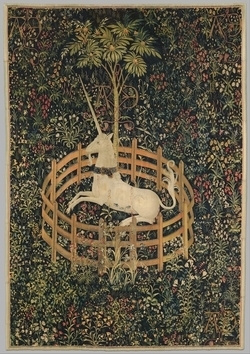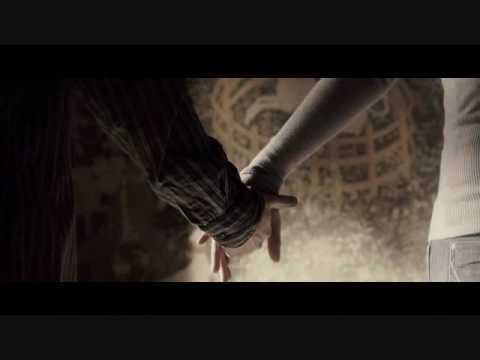Harry Potter and the Bestiary of Christ Part Two
You can read part one of this series here: http://phoenixweasley.wordpress.com/2011/06/19/harry-potter-and-the-bestiary-of-christ-part-one/ Now on to Part Two, in which the Christian symbolism of the unicorn is explained…
The Slaying of the Unicorn
In addition to the lion and the griffin, another symbol of Christ is the unicorn. Ancient and Medieval lore indicates that a unicorn's horn possessed miraculous powers of healing. Anyone who drank from the horn would be protected from disease or poison. The Dictionary of Symbolism by Hans Biedermann gives an account of the unicorn's power to cleanse water that has been fouled by a serpent. The early Christian Physiologus describes as follows the power of the horn to counter the effects of poison: before the other animals come to drink, "the snake comes forward and spits its venom into the water. The animals, however, knowing that the water is poisoned, do not dare to drink. They await the unicorn. The unicorn comes, goes right to the lake and makes a cross with its horn. This removes the effect of the poison. Only after the unicorn has drunk do the other animals approach and do likewise." (Biedermann 361)
Unicorns, which were once thought to be real animals, appeared in older translations of the Bible, such as the King James Version:
"…his horns are like the horns of unicorns: with them he shall push the people together to the ends of the earth…" (Deuteronomy 33:17, KJV)
"Will the unicorn be willing to serve thee, or abide by thy crib? Canst thou bind the unicorn with his band in the furrow? Or will he harrow the valleys after thee?" (Job 39:9-10, KJV)
These references to unicorns in the King James Bible occurred due to an error in translation. About three centuries before Christ, a group of scholars known as The Seventy translated the Old Testament from Hebrew into Greek. This translation is known as the Septuagint. The word for a type of wild ox, re'em, was translated monokeros, which means "single horned creature." The translators were unfamiliar with the word re'em because by that time the animal had become extinct. St. Jerome, in the late 4th century, used the Septuagint as the basis for his Latin translation of the Bible that was in use for many centuries. He translated the Greek monokeros as the Latin word unicornis. Many people understood this word to refer to the mythological unicorn, and therefore believed the animal must be real because it appeared in the Bible. Indeed, Rowling may know this story of why unicorns appeared in the King James Bible because it is apparent that she is familiar with the term re'em. She made use of this Hebrew word to refer to a rare golden ox whose blood gives the drinker immense strength. This reference can be found on page 36 of Rowling's own Fantastic Beasts and Where to Find Them. Perhaps she discovered the term when researching the lore of unicorns.
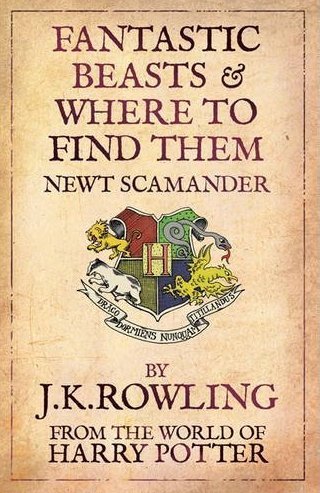
Fantastic Beasts and Where to Find Them: J. K. Rowling's own bestiary of the creatures in Harry's world.
In addition to the creature's appearance in the Bible, the early Church fathers wrote about the unicorn as a symbol of Christ. According to St. Basil the Great (329-375 A.D.), "Christ is the power of God, therefore he is called the unicorn because the one horn symbolizes one common power with the Father." St. Ambrose (339-397A.D.) also saw the unicorn as a symbol of Christ: "Who is the unicorn but the only begotten Son of God?"
Because of these associations with Christ, both the lion and the unicorn appeared as Christ symbols in Medieval and Renaissance artwork. Reproductions of The Lady and the Unicorn, a set of famous tapestries from the Museum of Cluny in Paris, appear as wall hangings in the Gryffindor Common Room in all of the Warner Brothers Harry Potter films.
A lion and a unicorn are depicted in each tapestry along with a female figure.
Another set of famous unicorn tapestries, currently housed in the Cloisters, the Medieval exhibit of the New York Metropolitan Museum of Art, is a set entitled The Hunt of the Unicorn as an Allegory of the Passion. These tapestries, woven in 1495-1505 in the Netherlands, depict the betrayal and passion of Jesus Christ as a unicorn hunt.
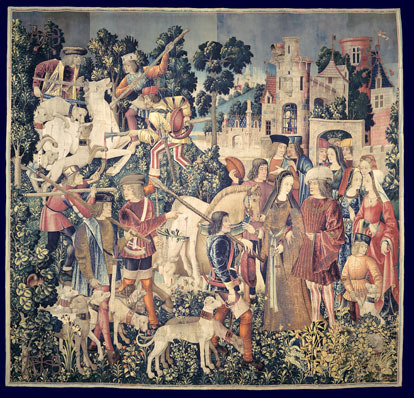
The Unicorn is Killed and Brought to the Castle. When the unicorn is slain, notice the holly tree depicted behind the unicorn. Harry's wand is made of holly with a phoenix feather core. In the Deathly Hallows, Harry (like the unicorn) is "killed" and brought to the castle.
Although the unicorn is killed in the sixth of the seven tapestries, he appears alive and well in the seventh tapestry. Here, the unicorn is a collared beast in a small enclosure, surrounded by a field of colorful flowers. "The Unicorn in Captivity" is symbolic of the resurrected Christ.
A unicorn tapestry copied from this famous work of art appears in the film Harry Potter and the Half-Blood Prince (2009), and can be seen clearly behind Ginny Weasley when she takes Harry by the hand in front of the Room of Requirement.

Here's a copy of The Unicorn in Captivity again. This is photo I took inside the Hogwarts Castle at the Wizarding World of Harry Potter theme park in the summer of 2010.
In the second tapestry of this series, entitled "The Unicorn is Found," the unicorn dips his horn into a stream, and is surrounded by other animals who are also Christian symbols, among them are the lion, the weasel, and the stag. All of these animal symbols are pertinent to this discussion of Harry Potter.
In the book, The Unicorn Tapestries, by Adolfo Salvatore Cavallo, the author explains the symbolism of the unicorn: "Early bestiaries indicate that the unicorn dips its horn into water that wild creatures need for drinking in order to purify it of the poisons that serpents have spewed into it. The allegory is clear: Christ takes on the sins of Man and so purifies him in order to bring about his redemption. The serpent is the devil; the poison he introduces into the world (the water) is sin. " (Cavallo 57)
In Harry Potter and the Sorcerer's Stone, Harry hears running water as he walks through the Forbidden Forest. He concludes that there must be a stream somewhere close by, and notices spots of unicorn blood along the path. (SS 251) He is aware that there is a creature in the forest that has been killing the unicorns. The stream and the slain unicorn both suggest the imagery of the medieval bestiaries as well as the iconography of The Hunt of the Unicorn as an Allegory of the Passion. Rowling's description of what Harry sees that night in the forest could be a scene from the crucifixion story that the tapestries portray:
Something bright white was gleaming on the ground. They inched closer.
It was the unicorn all right, and it was dead. Harry had never seen anything so beautiful and sad. Its long slender legs were stuck out at odd angles where it had fallen and its mane was spread pearly-white on the dark leaves.
Harry had taken one step toward it when a slithering sound made him freeze where he stood. (SS 255-256)
This is the hour of the Crucifixion, the hour of the Serpent's triumph. It was Voldemort who made the slithering sound over the dead leaves; he was the Great Serpent who murdered the unicorn. Harry's pain at encountering Voldemort in the forest is so great that he falls to his knees. (SS 256) The Dark Lord has done the unthinkable: he has been drinking the blood of the slain unicorn to sustain himself. His fear of death is such that he would slay the most worthy of creatures to sustain his unnatural life.
"…it is a monstrous thing, to slay a unicorn," said Firenze. "Only one who has nothing to lose, and everything to gain would commit such a crime. The blood of a unicorn will keep you alive, even if you are an inch from death, but at a terrible price. You have slain something pure and defenseless to save yourself, and you will have but a half-life, a cursed life, from the moment the blood touches your lips." (SS 258)
This passage echoes St. Paul's teaching on receiving Holy Communion, and those who receive it unworthily:
Wherefore whosoever shall eat this bread, and drink this cup of the Lord, unworthily, shall be guilty of the body and blood of the Lord. But let a man examine himself, and so let him eat of that bread, and drink of that cup. For he that eateth and drinketh unworthily, eateth and drinketh damnation to himself, not discerning the Lord's body. (1 Corinthians 11:27-29, KJV)
According to St. Paul, to drink the blood of Christ unworthily at Communion is to drink damnation upon oneself. This parallels Fierenze's claim that Voldemort has done the very same thing by drinking the blood of a unicorn, thus drinking a terrible curse upon himself.
Harry had a very strange dream in Harry Potter and the Prisoner of Azkaban, which may provide a link between the unicorn and the next Christ symbol that we will examine.
He was walking through a forest, his Firebolt over his shoulder, following something silvery-white. It was winding its way through the trees ahead, and he could only catch glimpses of it between the leaves. Anxious to catch up with it, he sped up, but as he moved faster, so did his quarry. Harry broke into a run, and ahead he heard hooves gathering speed. Now he was running flat out, and ahead he could hear galloping. (PA 265)
Was it a unicorn that Harry followed in his mysterious dream? Or was it something else? When Harry saw his corporeal patronus for the first time, he thought that, "It was as bright as a unicorn." (PA 385) But later, Harry will discover that the silvery-white creature that saved him from the dementors wasn't a unicorn at all…
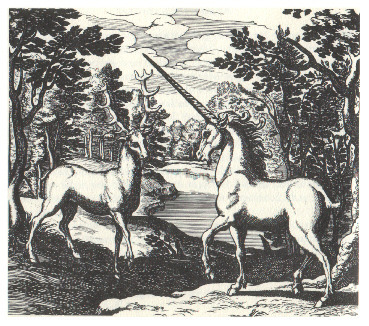
Illustration of the Stag and the Unicorn. Both are Christ symbols in Christian alchemical texts.
Please subscribe to this blog so that you don't miss the next installment of "Harry Potter and the Bestiary of Christ," which is entitled "The Hunting of the White Stag." If you would like to order a copy of my book, The Lord of the Hallows: Christian Symbolism and Themes in J. K. Rowling's Harry Potter, it can be obtained from www.outskirtspress.com/thelordofthehallows.
You can read more about the symbolism in "The Unicorn is Killed and Brought to the Castle" here: http://tinyurl.com/3e9agbv.
"Two episodes of the hunt narrative are brought together in this hanging. At left, two hunters drive their lances into the neck and chest of the unicorn, as a third delivers the coup de grâce from the back. It has been suggested that the doomed unicorn is an allegory for Christ dying on the Cross; the large holly tree (often a symbol of the Passion) rising from behind his head seems to reinforce this association. In the other episode, at right, a lord and a lady receive the body of the unicorn in front of their castle. They are surrounded by their attendants, with more curious onlookers peering through windows of the turret behind them. The dead animal is slung on the back of a horse, his horn already cut off but still entangled in thorny oak branches—probably symbolizing the Crown of Thorns. The rosary in the hand of the lady and the three other women standing behind the lord encourage a deeper reading of the scene, perhaps as a symbolic Deposition by the grieving Virgin Mary, John the Baptist, and the Holy Women."
When I think of the name given to that tapestry, I am reminded of how Harry was "killed" and brought to the castle in Harry Potter and the Deathly Hallows.
I recently found this quotation regarding the Eucharistic symbolism of both the unicorn and the stag, as well as their alchemical significance:
"The tinctures in alchemy relate also to the substances of the Mass, the red wine, the blood, and the white wafer, the body of Christ. Administration of the Sacraments was seen as spiritualising the souls of the partakers. In alchemical terms these white and red stones or tinctures served much the same purpose, though the alchemists achieved this, not through the intermediacy of a priest but by their own inner work of transmutation. Here alchemy links directly with the Grail stories which use similar parallels between the Grail and the Sacraments. The red tincture was occasionally symbolised by a stag bearing antlers. The stag being seen as a noble masculine animal. This links in with the Unicorn as a symbol of the white or feminine tincture. In some alchemical illustrations, such as that of the late 16th century Book of Lambspring, the Stag and Unicorn meet in the forest of the soul as part of the process of inner transformation." –from "Animal Symbolism in the Alchemical Tradition" by Adam McLean at http://www.levity.com/alchemy/animal.html.
The link between the Grail Stone of Parzival, the Philospher's Stone of alchemy, and the Resurrection Stone in Harry Potter was explored in The Lord of the Hallows if that topic is of interest to you. But that's a blog post for another day. 












